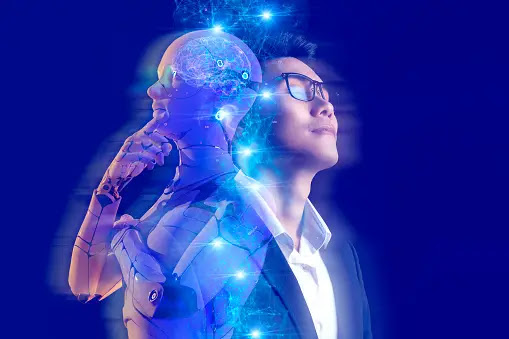In the quickly developing universe of innovation, Computerized reasoning (computer based intelligence) stands apart as a progressive power reshaping different businesses. Simulated intelligence's effect hands on market is significant, prompting huge changes in how organizations work. This article investigates instances of man-made intelligence supplanting human positions, featuring both the potential open doors and difficulties this shift presents.
 |
| Examples of AI replacing Human jobs |
Examples of AI replacing Human jobs | The rise of Automation in Workplace
1. Assembling and Mechanical production system Occupations
Producing is one of the areas generally impacted by computer based intelligence and mechanization. Robots and simulated intelligence driven machines currently perform undertakings that were once taken care of by human specialists. For example, car makers utilize automated arms to collect vehicles with accuracy and productivity, lessening the requirement for physical work. This progress increments efficiency as well as limits human mistake and work environment wounds.
2. Client assistance Agents
Simulated intelligence fueled chatbots and remote helpers have become ordinary in client assistance. Organizations convey these astute frameworks to deal with requests, resolve issues, and give data nonstop. Chatbots, for example, those utilized by banking and web based business stages, can handle enormous volumes of solicitations at the same time, offering fast and precise reactions. This lessens the requirement for human client support specialists, especially for routine requests.
3. Information Passage and Authoritative Assignments
Information passage, a generally monotonous and tedious work, is progressively being computerized through simulated intelligence. AI calculations can process and info information with high exactness, essentially decreasing the requirement for human information section assistants. Likewise, regulatory errands like planning, email the executives, and report taking care of are presently being overseen by simulated intelligence fueled devices, opening up human representatives for additional intricate and key exercises.
4. Monetary Administrations
In the monetary area, man-made intelligence is changing jobs like monetary examination and exchanging. Calculations can dissect tremendous measures of information continuously, going with informed choices and executing exchanges quicker than any human could. Robo-guides give computerized, calculation driven monetary arranging administrations with negligible human intercession, making speculation counsel more available and reasonable.
5. Medical services
Simulated intelligence is altering medical care by performing errands that reach from diagnostics to medical procedure. Man-made intelligence frameworks examine clinical pictures to recognize illnesses like disease with more prominent exactness than human specialists. Mechanical medical procedure partners assist specialists with carrying out complex techniques with accuracy. In spite of the fact that artificial intelligence improves medical care conveyance, it additionally raises worries about the dislodging of medical care experts in specific regions.
6. Transportation and Coordinated operations
The transportation business is near the precarious edge of a significant change with the coming of self-driving vehicles. Organizations like Tesla, Waymo, and Uber are putting vigorously in independent vehicle innovation. These simulated intelligence driven vehicles vow to lessen the requirement for human drivers in both individual and business transportation, possibly upsetting position in shipping, taxi administrations, and conveyance administrations.
7. Retail and Warehousing
Man-made intelligence and mechanical technology are fundamentally affecting the retail and warehousing areas. In distribution centers, robots handle errands like arranging, pressing, and stock administration. Amazon's satisfaction communities, for instance, use robots to smooth out activities and increment productivity. In retail locations, man-made intelligence driven frameworks oversee stock, streamline estimating, and improve client encounters through customized suggestions.
This Business Truly Changing Event
For the past couple of years, many businesses have sought to use AI chatbots to manage customer requests regarding their company. Automated, immediate and can serve hundreds of thousands of simultaneous interactions at a time, it will be the most effective communication tool available 24/7. AI chatbots often help large corporations with inquiries about accounts, orders, and troubleshooting and sometimes even manage complicated services, from customers such as Amazon or Meta or banks like The Bank of America.
The extent of this change has led to a drastic reduction in the size of customer support departments. Instead of employing agents prepared to respond to the hundreds who call daily with the same repetitive questions, businesses now equip themselves with a few AI-enabled tools that can provide uniform and accurate answers. According to a 2023 McKinsey report, such automation will displace as much as 70% of consumer interactions and lead to a corresponding drop in entry-level customer service jobs.
Why Companies are Adopting AI?
There are several reasons behind using such solutions by organizations at a fast pace.
Cost Saving: AI reduces labor costs and training costs.
Speed and Availability: AI is constantly active without having to take the rest, leave or vacations.
Scalability: AI will grow to manage any kind of work load with the same efficiency without needing additional personnel to take on the new responsibilities.
Insights from Data: AI tools will collect and analyze customer data and index it for making improvements as well as personalized user experiences.
Conclusion
The idea that AI can take over human jobs is no longer a distant theory, but a reality. A concrete instance of this in place is the customer service arena, wherein automation is reshaping the workplace. While the transition does pose challenges, it also opens doors for innovations and the creation of new job opportunities. Therefore, a concerted effort to embrace these changes will ensure their adoption, be it corporate or labor.




0 Comments